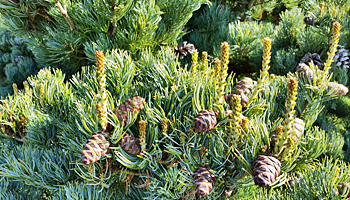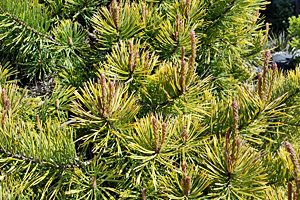Plant of the Week- Pinus species or Pines
Walking around the nursery and the display beds at the farm this week, I can see the various pines are waking up and starting to grow. Their new growth tips are one of the true signals that spring is really here! Conifers (and other evergreens) provide structure and texture to any garden, and their wide array of colors can create a soothing background to brighter flowers and deciduous foliage. They also add winter interest when other plants are dormant.

New candles on a Japanese White Pine
Pines are a large group of conifers, and there are selections that stay very small, almost growing as ground covers, and selections that grow to very large trees in a few years. There are pines with deep green needles, and pines with bright yellow needles, so they can add great color to sunny spots. All pines prefer full sun, and many are not fussy about soil as long as it is not too wet. Bonus- deer do not find pines tasty!

A golden Scots pine, candles pushing
Upright forms of pine in the garden provide shelter for birds. They are very hardy and can be used for screens and windbreaks. Two needled pines, including our native shore pine, Pinus contorta var. contorta, can tolerate drought and wet, and are great structural plants in the landscape.
Pine grow each year by pushing growth tips called candles. These candles emerge in late April or early May. By pruning these candles before the needles fully form, you can keep your pines compact and dense.
The candles usually emerge in clusters. Removing one third to one half of most of the candles will cause them to branch. When the energy goes into multiple growing tips, each tip grows a little less long, keeping the pine more dense. If there are too many candles, whole candles can be removed from the cluster.
By annually candle pruning pines, even vigorous plants can be kept from growing too large for the garden. Additional pruning to remove branches and open up the structure of the pine can be done at the same time. Be sure to wear gloves – your hands will get sticky!

